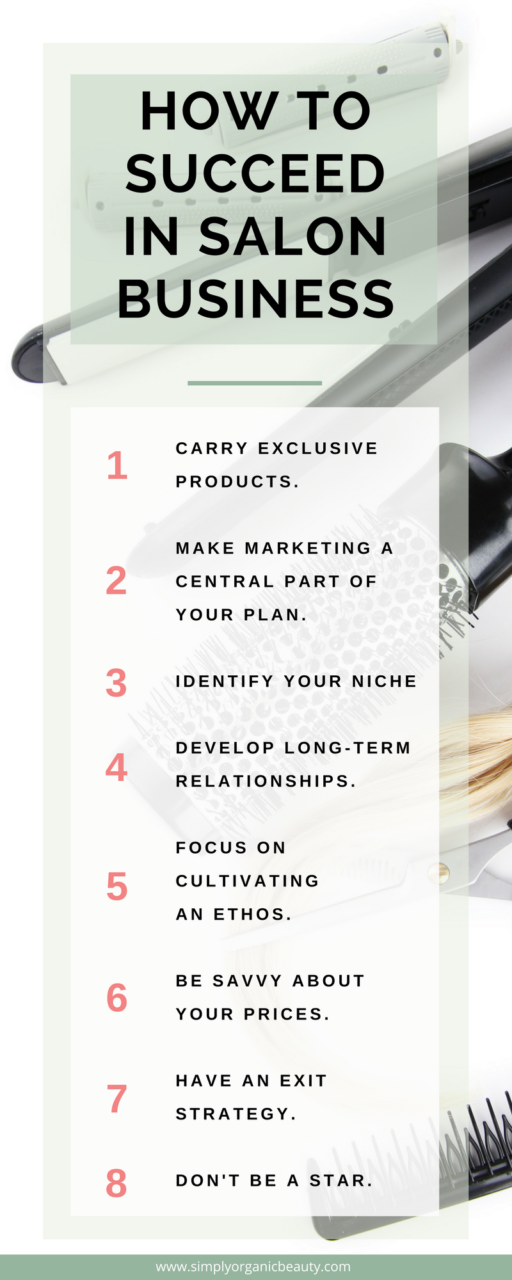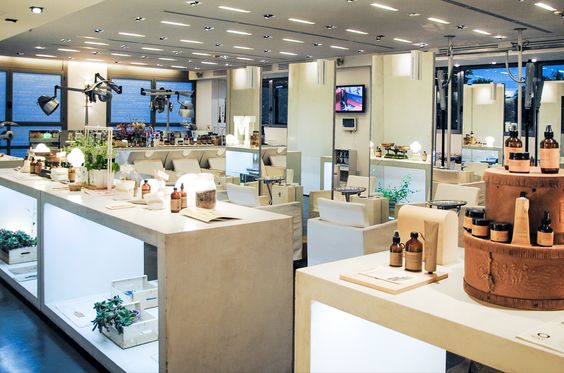With today’s growing salon industry, owning a successful salon has helped many salon professionals achieve real financial independence. More and more owners are selling their salons and retiring as multi-millionaires, which only happened in a few rare cases twenty years ago.
But the road to salon success has considerably changed. Yesterday’s salon owner strived to make a good living and be the star in their successful salon. Today’s salon owner aims to build real value and retire financially independent so they can travel the world and enjoy the fruits of their risk and hard work.
The modern salon owner is far more entrepreneurial, creative, savvy, and innovative than their predecessors. There is almost universal agreement amongst today’s young “salon-trepreneurs” that yesterday’s rules to running a salon will, at best, only lead to providing a good living. But to achieve the kind of success that is available in today’s thriving and ever-changing salon industry, salon owners have to master this new set of rules.
How to Succeed in Salon Business
RULE 1: Carry Exclusive Products
 Let’s face it: There are 25 salons within a few miles of your business that offer L’Oreal, Redken, Wella, Pureology, Bumble and Bumble, and Paul Mitchell. If you have any doubt on this, just put the name of your town, your state, and then your brand into Google, and you will know. When it comes to hair color, the real consumer sentiment is even worse. In a recent survey of 1,000 non-cosmetologist salon hair color clients, less than 1% thought they knew what brand of hair color their hair colorist used. What’s even worse is that half of them guessed wrong when they identified the brand!
Let’s face it: There are 25 salons within a few miles of your business that offer L’Oreal, Redken, Wella, Pureology, Bumble and Bumble, and Paul Mitchell. If you have any doubt on this, just put the name of your town, your state, and then your brand into Google, and you will know. When it comes to hair color, the real consumer sentiment is even worse. In a recent survey of 1,000 non-cosmetologist salon hair color clients, less than 1% thought they knew what brand of hair color their hair colorist used. What’s even worse is that half of them guessed wrong when they identified the brand!
This situation even gets grimmer when we introduce the topic of product diversion. Despite the fact that product manufacturers accuse rogue distributors of selling their products to Target, CVS, Walmart, and Amazon; you would realize that this is simply not true. Given the requirements of these mega-retailers (such as product liability insurance and certificates of trademark ownership), only a product manufacturer can get their products some shelf space in these megaretailer’s stores and that is only after months of effort. While your sales rep is telling you they are selling professional-only products; you can do a simple search on the websites of Target, Amazon, or CVS to find that your clients can find the same products for much cheaper at these stores. We’ve all heard before that these are not the same products, but we all know that they are exactly the same.
If you want to offer a truly salon-exclusive line of products that are only available to licensed professionals that have actually recommended the product for a client’s specific needs, then you should consider Simply Organic Beauty and their line of hair color, hair care, and salon treatments.
RULE 2: Make Marketing a Central Part of Your Plan
To have a successful salon, you have to have loyal clients who receive real value from your services and feel an affinity to your brand and ethos. To many salon owners, marketing means advertising. Avoid this mistake. According to the American Marketing Association, marketing is “the set of activities for creating, communicating, delivering, and exchanging offerings that have value for clients.”
Your marketing strategy should include equal parts of advertising, promotion, and communication. Advertising is media that is paid for to attract clients to your salon. Examples of advertising initiatives would be placing a print ad in your local paper, renting a billboard, or running an ad campaign on your local radio station. Promotion doesn’t necessarily require paid media, but it has to be more creative to attract new clients. Examples of promotions would be hosting a “Bring a Friend” night, having a referral program in your salon, providing employee discount programs for large local employers, or appearing as a guest speaker on a local radio talk show. Communication, on the other hand, means creating a clear presence for your salon. Examples of communication would be ensuring you have visible and attractive signage, issuing press releases about noteworthy events to your local newspapers, and having an easy-to-find website that is listed in all local directories.
RULE 3: Identify Your Niche
For most salons, traditional advertising is extremely difficult and will have limited returns. The primary reason for this is the competitive landscape that many salons face where too many salons provide almost identical services and compete for a limited number of clients. To successfully advertise your salon, you must develop USP’s (Unique Selling Propositions). In other words, you must have something different to offer. Otherwise, your salon is going to look like all of the others no matter how attractive your ad is. Most experts say that unless you have a highly specialized or differentiated offering, you are better off not advertising at all. Unfortunately, we agree.

The good news is that if you are offering organic salon products from a company like Simply Organic Beauty, you are offering something different! Advertising how healthy, safe, and nourishing your products will send out a message that sets your salon apart from your competition. This message will certainly resonate with clients that are specifically concerned about their health and well-being. Further, you can target these clients and get a much better return on your advertising dollars. Rather than advertise in your local newspaper where you pay a high price for exposure, why not advertise in your local organic newsletter where the rates are much cheaper, and all of the readers will be looking for a salon just like yours? By targeting your advertising budget specifically to your niche audience, you will spend less money and get many more clients from your advertising budget!
RULE 4: Develop Long-Term Relationships with Your Clients
 Today’s consumers want to feel a connection with the products and services they use. Great companies like Apple, Disney, and Coca-Cola have mastered this art and your salon can too. Rather than providing your client with a short service that enhances their beauty until their next visit, develop a program of care that begins with the service and then maintained and enhanced by the use of products, followed up by return visits to your chair. DON’T SELL THEM PRODUCTS – they don’t want or need to be sold anything. Instead, recommend a path for them to achieve their beauty and wellness goals and offer professional yet personalized guidance throughout the treatment. Think more homeopathic and holistic rather than service and cosmetic. This is exactly the sort of expert advice and consultation that the modern salon client is yearning for, and providing them that invaluable service will help you develop a meaningful relationship with them.
Today’s consumers want to feel a connection with the products and services they use. Great companies like Apple, Disney, and Coca-Cola have mastered this art and your salon can too. Rather than providing your client with a short service that enhances their beauty until their next visit, develop a program of care that begins with the service and then maintained and enhanced by the use of products, followed up by return visits to your chair. DON’T SELL THEM PRODUCTS – they don’t want or need to be sold anything. Instead, recommend a path for them to achieve their beauty and wellness goals and offer professional yet personalized guidance throughout the treatment. Think more homeopathic and holistic rather than service and cosmetic. This is exactly the sort of expert advice and consultation that the modern salon client is yearning for, and providing them that invaluable service will help you develop a meaningful relationship with them.
The system offered by Simply Organic Beauty is ideal for achieving this purpose. For instance, beginning the treatment with a wet stretch test will help establish a verifiable baseline of your client’s hair. Then, monitor the client’s hair condition after the in-salon treatment and while they’re using your recommended products at home. When the client returns, you can test and verify the results together. Doing so will help reinforce their loyalty.
RULE 5: Focus on Cultivating an Ethos Rather Than Developing an Image
We have all heard it thousands of times before: A salon is all about image. For the modern salon, nothing could be further from the truth. Today’s “Starbucks” and “Whole Foods” consumers are loyal to a salon for what it represents rather than how it looks. Long gone are the days when laser lights, loud pop music, and rhinestone-studded hair brushes are attracting new clients like ants to a picnic. Today, the concept of “building an image” has been replaced by “building client affinity.” Client Affinity is defined as having an inherent similarity, feeling of kinship, or natural attraction to a business. In the modern salon industry, client affinity equals loyalty.
The most efficient way to build affinity with clients is to develop a strong ethos (a set of salon values, goals, culture, and mission) which your target audience is likely to share. Take some time and assess what your target clientele values and build your salon’s culture around those to ensure client affinity and long-lasting loyalty. If you’re an organic salon, your clients probably value their health, well-being, and social and environmental stewardship. These values are consistent with the Simply Organic Beauty Ethos and are an ideal way to promote client affinity.
RULE 6: Be Savvy About Your Prices
 One of the most common misconceptions of the salon industry is that when salons raise their prices, they might scare new clients away. While this is normally true in most industries, savvy salon owners have realized that higher prices on their services menu allow them to provide more attractive discounts in their promotional programs.
One of the most common misconceptions of the salon industry is that when salons raise their prices, they might scare new clients away. While this is normally true in most industries, savvy salon owners have realized that higher prices on their services menu allow them to provide more attractive discounts in their promotional programs.
For example, if you increase the prices on your services by 20%, but offer a 20% discount for friends and family of current clients, you have increased the perceived value of your services, increased client loyalty from your referral network, and allow for higher prices from potential new clients whose perception of higher value in your services has been driven by the positive remarks of your loyal clients. While we do not recommend increasing your service prices to some unreasonable amount, we have found that almost all salons would benefit from adopting this approach to some extent so long as the increase is reasonable.
RULE 7: Have an Exit Strategy
Starting and running a new business is a risky endeavor. As human beings, we instinctually want to identify an exit whenever we step into even a moderately risky situation. For example, when we walk into an elevator or onto an airplane, we instantly want to know where the exit is. Why is it that salon owners rarely have an exit plan?
To define your exit strategy for your salon, you’ll need to develop your personal long-term plan. How much money do you want to have to retire? How much money do you want to sell your salon for? Do you want to leave the business to your children? Is your goal to expand to multiple locations? Understanding your goals for yourself and your business and synchronizing these with your personal finances will help you define what your exit strategy is.
RULE 8: Don’t Be a Star
 Whether your exit strategy is to sell your salon, leave it to your children, or slowly pass it on to your staff; it is important that you build an independent business that has value in and of itself. The biggest mistake made by salon owners is developing a business based ON their talents rather than building a business FROM their talents. If your salon is successful, its lifespan as a business will outlast your career, and your payoff will be passing a wonderful business on to your successor (whether that is your children or someone who has bought your salon from you). Whichever the case, the only way to know if you are passing on something of value is if your salon can be just as successful if you are not involved in the business. This should be your ultimate goal. To do this, you will have to put your ego aside and commit to building a great business.
Whether your exit strategy is to sell your salon, leave it to your children, or slowly pass it on to your staff; it is important that you build an independent business that has value in and of itself. The biggest mistake made by salon owners is developing a business based ON their talents rather than building a business FROM their talents. If your salon is successful, its lifespan as a business will outlast your career, and your payoff will be passing a wonderful business on to your successor (whether that is your children or someone who has bought your salon from you). Whichever the case, the only way to know if you are passing on something of value is if your salon can be just as successful if you are not involved in the business. This should be your ultimate goal. To do this, you will have to put your ego aside and commit to building a great business.
Statistics consistently show that businesses with sustainable profits sell for 7 to 10 times their annual profits. Unfortunately, salons usually sell for two times their annual profit because when their owners leave, so do their profits. Therefore, most salons are sold for less than their furniture and fixtures. To put that into perspective, if you build a salon business that generates $300,000 per year in profits, you could probably sell that business for $600,000 if you built a business ON your talents and made yourself the star of your salon or $3 Million if you built a business with sustainable profits even if you are no longer working for the business.
Summary
The modern salon industry offers considerable opportunity to generate real wealth for owners and investors. But the emerging opportunities call for a different set of rules than the traditional salon industry.




